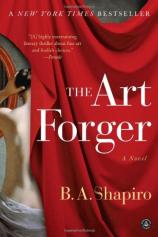The Art Forger
Review
The Art Forger
It’s been a lousy year for paintings. A woman in Zaragoza, Spain, tried to restore García Martínez’s “Ecce Homo” and turned the portrait of Jesus into a hilarious Internet meme. A Polish national scrawled his name on a Mark Rothko mural at London’s Tate Modern. And most recently, thieves stole works by Picasso, Gauguin and others from a museum in Rotterdam. This last incident is reminiscent of one of the great art heists ever: the 1990 theft of 13 artworks, valued at over $500 million, from Boston’s Isabella Stewart Gardner Museum. Twenty-two years later, their whereabouts are still unknown.
In her new novel, THE ART FORGER, B.A. Shapiro has fun with an engaging premise: What if the whereabouts of one of the Gardner paintings is known, and the robbers hire someone to paint a reproduction of it? The result is not the literary thriller the publisher is calling it but an entertaining art caper in the spirit of Peter Mayle’s CHASING CEZANNE, although Shapiro’s work is less fizzy than its predecessor.
"Shapiro has written a highly entertaining book. If you love the process of creating art, or want to learn more about it, you’ll enjoy the scenes of Claire’s labors and investigations.... The scenes in which Claire creates her own paintings and studies the Degas for authenticity are among the book’s strongest."
Claire Roth is a 31-year-old Boston painter. Three years earlier, she helped Isaac Cullion, her 44-year-old married boyfriend, complete a painting he was too blocked to confront. The result, entitled “4D,” became an immediate sensation. New York’s Museum of Modern Art, believing that Cullion painted the work himself, purchased it. Soon, he was appearing on national television and in major magazines. Not long after his first taste of success, he told Claire that he was leaving her to reconcile with his wife. Her response was to tell the curator at MoMA that she, not Cullion, was the creator of the work. The claims and counterclaims that ensued tarnished Claire’s reputation, especially after a devastating event that irrevocably altered the lives of everyone involved.
Claire’s main source of income since then has come from painting reproductions of famous works for the online firm Reproductions.com. In her spare time, she works on a series of paintings of windows but has found neither buyers for her work nor a gallery willing to install her pieces.
One afternoon, she receives an unexpected visit from Aiden Markel, the owner of Markel G, a prestigious Boston art gallery. He offers her a business proposition: He wants her to forge a painting and promises to pay her $50,000 for her efforts, far more than her usual fee. And if she agrees to paint the forgery, he will give her a one-woman show at his gallery.
But the proposition has a catch. The painting Markel wants her to forge is After the Bath, one of the Degas paintings he says was stolen from the Gardner. (Actually, Degas painted many works of women emerging from the bath, but none were among the Gardner pieces.) Markel’s plan is to return the Degas to the Gardner and sell Claire’s copy to an investor who thinks he’s buying the original. Claire accepts the commission, but as she begins painting her reproduction, she starts to doubt that the painting Markel has given her is the stolen Degas. What follows is a complex tale of academic scholarship, tarnished reputations and the quest for redemption.
The prose in THE ART FORGER is workmanlike throughout and not especially memorable. There’s a lot of unnecessary stage direction, and some of it is of the pulp cinema variety; no one I know snaps her fingers when an idea occurs to her. And I can’t believe that, as Markel claims, an investor would remain quiet if he learned that a painting he had paid millions for on the understanding that it was an original turned out to be a copy.
Yet, despite all of this, Shapiro has written a highly entertaining book. If you love the process of creating art, or want to learn more about it, you’ll enjoy the scenes of Claire’s labors and investigations. Shapiro writes well about craquelure and wet-on-wet techniques, and the use of a jeweler’s loupe to examine a painting’s brushstrokes. The scenes in which Claire creates her own paintings and studies the Degas for authenticity are among the book’s strongest. And one could learn a lot about pacing from Shapiro’s novel. Her book may be populated with stock characters, but she knows how to create tension and build a story to a satisfying conclusion. THE ART FORGER is a fun trifle and perfect light reading for fanciers of great works of art.
Reviewed by Michael Magras on October 26, 2012





